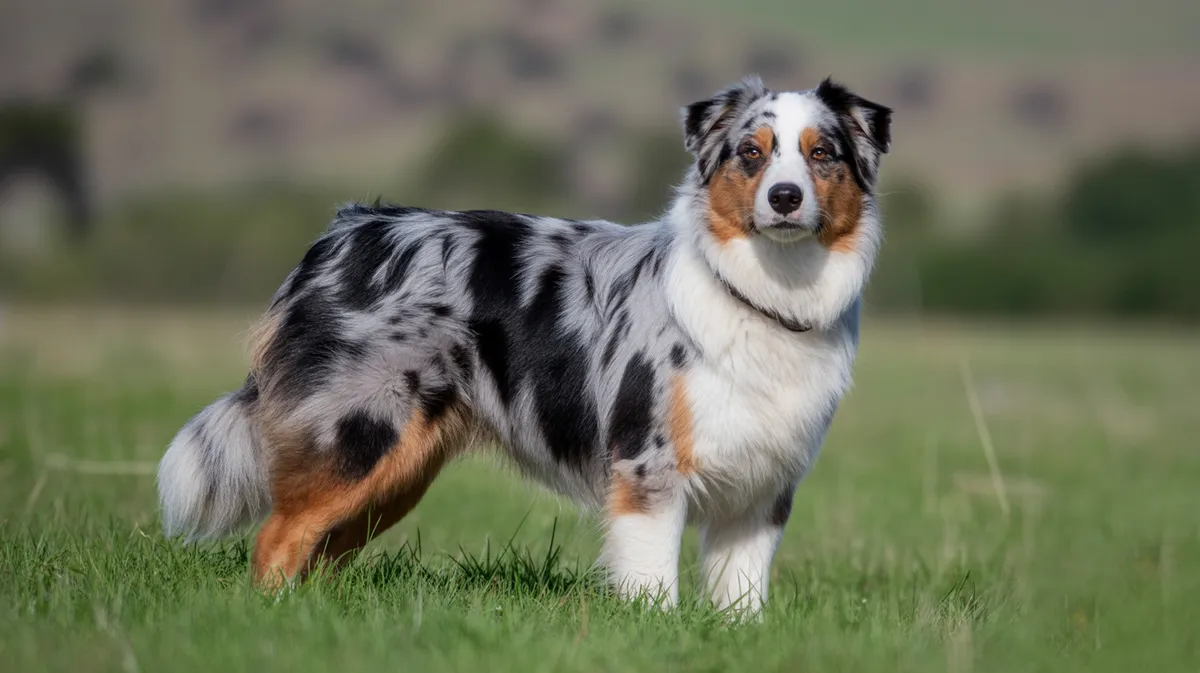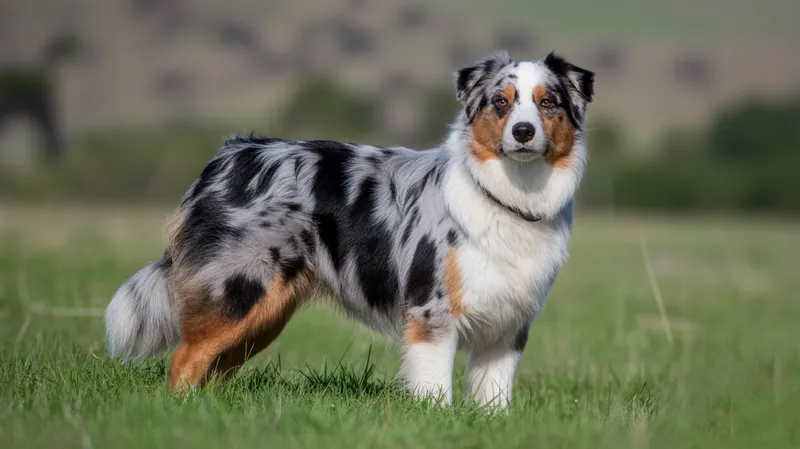
Australian Shepherd
Canis lupus familiaris

Meet the Australian Shepherd
The Australian Shepherd is a highly intelligent and energetic breed of domestic dog known for its exceptional herding abilities. Despite its name, the breed was developed in the United States in the 19th century to work as a livestock herder, especially for sheep. Australian Shepherds are medium-sized, with a striking coat that can be merle, black, red, or blue, often with distinctive markings and bright, expressive eyes. They are celebrated for their agility, trainability, and loyalty, making them excellent companions for active families and working environments. This breed thrives on mental stimulation and physical activity, requiring regular exercise and engagement.
Classification
Mammal
Habitat
Grassland, ranches, and farms
Diet
Omnivore
Lifespan
12-15 years
Conservation
Least Concern
Weight
18-29 kg (40-65 lbs)
📖Fascinating Facts
Highly Intelligent
Australian Shepherds are ranked among the most intelligent dog breeds, making them easy to train and quick to learn new tasks.
Energetic Workers
This breed requires significant daily exercise and mental stimulation due to its origins as a working herding dog.
Unique Eyes
Many Australian Shepherds have striking blue, amber, or even two different colored eyes, a trait known as heterochromia.
📋Detailed Description
The Australian Shepherd is a medium-sized, well-balanced herding dog, typically weighing between 35 and 70 pounds (16–32 kg) and standing 18 to 23 inches (46–58 cm) at the shoulder, with males generally larger than females. Its body is slightly longer than tall, giving it an agile, athletic build suited for sustained work. The breed's hallmark is its moderately long, weather-resistant double coat, which comes in striking colors such as blue merle, red merle, solid black, or red, often accented by white markings and copper points. Eyes are expressive and may be brown, blue, amber, or heterochromatic, contributing to the breed's distinctive appearance. Australian Shepherds possess a keen intelligence and high energy levels, traits honed by generations of selective breeding for livestock management. Their movement is smooth and efficient, enabling them to cover large distances with minimal effort. The breed is known for its strong work ethic, responsiveness to training, and versatility in various canine sports and working roles. Socially, Australian Shepherds form strong bonds with their families and may display protective instincts. Their acute senses and problem-solving abilities make them adept at complex tasks, from herding to search and rescue. Life expectancy averages 12–15 years, with proper care and regular exercise being crucial for their well-being.
💡 Did you know?
Despite its name, the Australian Shepherd was actually developed in the United States, not Australia.
🔬Research & Sources
Wikipedia Summary
The Australian Shepherd is a breed of herding dog from the United States. The name of the breed is technically a misnomer, as it was developed in California in the 19th century. It is believed to have its origins in sheepdog breeds from northwest Spain, as well as collies imported, alongside sheep, from Australia and New Zealand; the breed reportedly took its name from this trade. Originally used solely as a herding dog, the Australian Shepherd has become one of the most popular companion dog breeds in North America.
Last Modified: 6/6/2025
🎭Behavior & Social Structure
Australian Shepherds are highly active and thrive on both physical and mental stimulation. Their herding instincts manifest as a tendency to herd children, other animals, or even moving objects. They excel in structured activities such as agility, obedience, flyball, and herding trials, often requiring several hours of exercise daily to prevent boredom and destructive behaviors. Socially, they are affectionate with their families but may be reserved or cautious around strangers, a trait rooted in their working heritage. They are known for their problem-solving skills and ability to learn complex commands quickly. Feeding behavior is typical of domestic dogs, with a preference for high-quality, protein-rich diets; however, their energy expenditure may necessitate higher caloric intake than less active breeds. Australian Shepherds often develop strong attachments to their primary caregivers and may experience separation anxiety if left alone for extended periods. Their daily routines should include interactive play, training sessions, and opportunities for off-leash running in secure areas.
👶Reproduction & Life Cycle
Australian Shepherds reach sexual maturity between 6 and 12 months, though responsible breeding is typically delayed until at least two years of age to ensure physical and behavioral maturity. The breed exhibits no strict breeding season, but most litters are planned to coincide with favorable weather and resource availability. The estrous cycle in females lasts about 21 days, with gestation averaging 63 days. Litter sizes range from 6 to 9 puppies, though larger litters are not uncommon. Parental care is primarily provided by the dam, who nurses and grooms the puppies for the first 3–4 weeks, after which weaning begins. Breeders often perform early neurological stimulation and socialization to promote stable temperaments. Responsible breeders screen for hereditary conditions such as hip dysplasia, epilepsy, and certain eye disorders to ensure the health of future generations.
🛡️Adaptations & Survival
Australian Shepherds possess several adaptations that enhance their effectiveness as herding dogs. Their double coat insulates against harsh weather, allowing them to work in diverse climates. The breed's agility, endurance, and quick reflexes are products of selection for livestock management in rugged terrain. Their acute hearing and keen eyesight enable them to detect subtle cues from both livestock and handlers. Behaviorally, their intelligence and trainability facilitate rapid learning of complex tasks and commands. The breed's natural wariness of strangers, combined with loyalty to their family, provides a balance of protectiveness and sociability. Their strong prey drive and instinct to control movement are direct results of their herding ancestry.
📚Research Sources
🎨Cultural Significance
The Australian Shepherd holds a prominent place in North American ranching and agricultural culture, symbolizing diligence, intelligence, and partnership between humans and working dogs. The breed is celebrated in Western folklore and has featured in rodeos, equestrian events, and popular media. Its versatility has made it a favorite in canine sports and service roles, including search and rescue, therapy, and assistance work. The breed's striking appearance and engaging personality have contributed to its status as a beloved companion and cultural icon in rural and suburban communities alike.
🔬Recent Research & Discoveries
Recent genetic studies have clarified the breed's origins, confirming a mix of Basque and British herding dog ancestry, with subsequent development in the American West. Ongoing research focuses on the genetic basis of merle coloration and associated health risks, such as deafness and vision impairment in homozygous merle individuals. Behavioral studies have explored the breed's cognitive abilities, revealing advanced problem-solving skills and a strong capacity for learning complex tasks. Veterinary research continues to address breed-specific health concerns, with emphasis on early screening and preventive care.
🎥Wildlife Videos

Secrets of the Outback | Wild Australia in 4K | Wildlife Nature Documentary
To many, Australia's Outback seems barren and inhospitable — a vast, sun-scorched wilderness with little life to offer. But look ...
Into the Wild Films

Pug, Rottweiler, and Mini Australian Shepherd Puppies! | Too Cute! (Full Episode)
Follow these three litters of adorable puppies as they grow up and get up to all sorts of mischief! Stream Full Episodes of Too ...
Animal Planet

Australia’s Unbelievable Native Animals 4K • Relaxation Film with Peaceful Music | 4K Ultra HD
Discover Australia's most iconic native animals — from sleepy koalas to bouncing kangaroos — in this immersive 4K Relaxation ...
Relaxation Film

WILD AUSTRALIA | The Continent of the Strangest Predators #naturedocumentaries | Wild Nature
WILD AUSTRALIA | The Continent of the Strangest Predators #naturedocumentaries Welcome to an epic adventure through ...
WILD NATURE - Nature animal documentary

Wildlife | Episode 3: Kangaroos - Kings of the Outback | Free Documentary Nature
Wildlife - Episode 3: Kangaroos - Kings of the Outback | Wildlife Documentary Watch 'Wildlife - Episode 4: World's Largest Land ...
Free Documentary - Nature

Dogs with jobs are protecting Australia's wildlife | WILD HOPE
Dogs are often thought of as humans' best friends. But in Australia, they're partnering with people to save other species from ...
Nature on PBS
🌍Habitat Information
The Australian Shepherd typically inhabits Grassland, ranches, and farms environments. Australian Shepherds have adapted to their environments with specialized features and behaviors.
Primary Habitat:
Grassland, ranches, and farms
More detailed habitat information will be available soon.
🛡️Conservation Status
The Australian Shepherd is currently classified as Least Concern. Conservation efforts are crucial for preserving this species for future generations.
Common Threats:
- 🏠Habitat loss and fragmentation
- 🌡️Climate change impacts
- 🎯Hunting and poaching
- 🏭Human-wildlife conflict
⚠️Threats & Conservation Challenges
As a domestic breed, Australian Shepherds face few natural threats, but several challenges exist due to human influence. Overbreeding and irresponsible breeding practices have led to an increased incidence of hereditary health issues, including hip and elbow dysplasia, epilepsy, and eye conditions such as cataracts and Collie Eye Anomaly. The breed's high energy and intelligence can result in behavioral problems if their needs are not met, leading to abandonment or surrender to shelters. Urbanization and reduced demand for traditional herding work have shifted the breed's role to that of companion and sport dog, sometimes resulting in mismatches between breed traits and owner lifestyles. Despite these challenges, the breed's popularity remains high, and population trends are stable.
🔬Scientific Classification
Scientific Name
Canis lupus familiaris
Classification Hierarchy
🔍 About Taxonomic Classification
Taxonomic classification is a hierarchical system used by scientists to classify and organize living organisms based on shared characteristics and evolutionary relationships.
The system moves from broad categories (Kingdom) to increasingly specific ones, with each animal's scientific name typically consisting of its Genus and species.
📝Community Notes
Share your observations and insights about the Australian Shepherd with our community of wildlife enthusiasts.
Join Our Community
Sign in to share your observations and connect with fellow wildlife enthusiasts.
Sign In to ContributeNo community notes yet
Be the first to share your observations about the Australian Shepherd!
Explore Australian Shepherd
Select a tab above to learn more about this amazing animal.
📸Photo Gallery
No photos available for this animal yet.
🌟Discover More Wildlife
Continue your journey of discovery with more fascinating animals from our database
